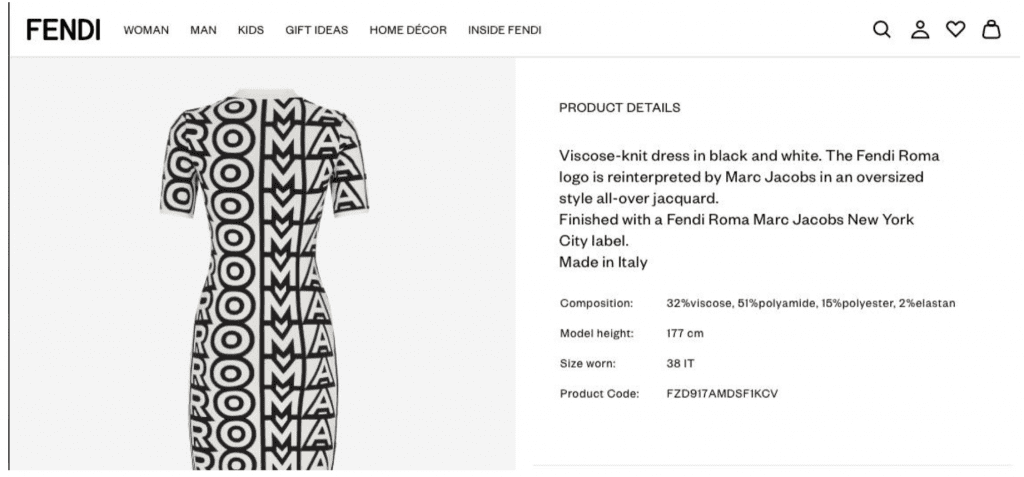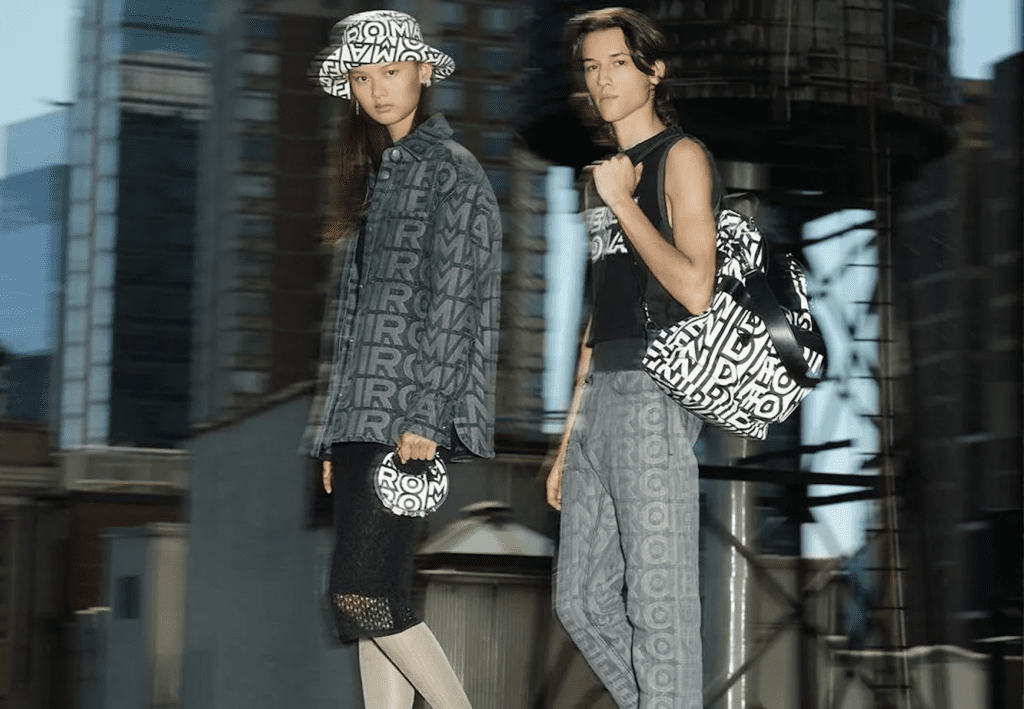Fendi and Marc Jacobs have landed on the receiving end of a new trademark lawsuit in the wake of the release of a collaborative collection this fall. According to the complaint that it lodged with the U.S. District Court for the Central District of California on December 15, Los Angeles-based clothing, accessories, and costume design and manufacturing company Roma Costume claims that the two LVMH-owned brands have used and continue to use a “reimagined” version of Fendi’s “Roma” logo that is “confusingly similar” to its own Roma trademark to sell “competing goods to many of the same consumers” that it targets with its own offerings.
In the newly filed complaint, Roma Costume asserts that “sometime before December 2022,” Fendi and Marc Jacobs (the “defendants”) “purportedly reimagined” Fendi’s existing “Roma logo,” which consists of “the stylized wording ‘FENDI’ in larger size font stacked on top of ‘ROMA’ with the wording appearing bigger in the middle than on the sides.” Notwithstanding its “established rights in the ROMA mark,” Roma Costume alleges that the defendants’ new iteration of the Fendi mark puts “ROMA” at the “center” of Fendi’s offerings – from $2,800-plus ROMA-emblazoned handbags and bucket hats to $1,400 dresses and jackets.
In terms of its own rights, Roma Costume points to two registrations (Nos. 4330234 and 4330235) for the word marks ROMA and ROMA COSTUMES for use on “fitted clothing for women, namely, costumes,” and the “substantial goodwill” thanks to decades of use of “the distinctive ROMA mark.” Both registrations were issued in 2013. Roma Costume also claims that it has spent “significant sums advertising and promoting its goods and services throughout the United States and under the ROMA mark,” alleging that its offerings “are sold under the ROMA mark in shops throughout the United States, on [its] website, and on online shops.”

With the foregoing in mind and given that Fendi and Marc Jacobs’ use of the Fendi Roma logo allegedly “has caused and is likely to continue to cause consumer confusion, reverse confusion, mistake, and/or deception,” Roma Costume sets of claims of trademark infringement and unfair competition, and is seeking injunctive relief, as well as monetary damages. In connection with its injunction request, Roma Costume not only wants the court to bar the defendants from using the “Roma” mark but also wants the court to enjoin the Director of the U.S. Patent and Trademark Office from issuing any trademark registrations for the Reimagined Fendi’s Roma logo to them and wants the court to also order that any previously granted registrations for the Roma mark to be cancelled. (Note: Fendi does not maintain any U.S. trademark registrations for the bold “Roma” branding, and in fact, in any registrations that it does have that include Roma, it disclaims rights in the word “Roma” on its own.)
As for the strength of Roma Costume’s case against the two fashion brands, it very well may not be an easy win. If nothing else, there is room for argument when it comes to the likelihood of confusion. While Roma Costume argues that consumers have been – and are likely to continue to be – confused by the “reimagined” Roma mark created by Fendi and Marc Jacobs (and thus, associate Fendi goods bearing that mark with itself), at least one factor strongly suggests otherwise: the Marketing/Advertising Channels (i.e., the channels of trade).
This factor jumps out, as Roma Costume claims that it is targeting the “same consumers” as Fendi and Marc Jacobs – which might not be entirely true – and thus, the defendants’ use of the Roma mark is likely to confuse consumers. What Roma Costume does not assert in its complaint (but states on its website) is that it is a wholesale manufacturer. This would likely be significant in a review of the likelihood of confusion factors (Sleekcraft in the Ninth Circuit), which consider the marketing/advertising channels at issue, among other things. In other words, if the plaintiff’s and defendant’s goods/services are likely to be sold in the same or similar stores or outlets, or advertised in similar media, this may increase the likelihood of confusion.

A quick review of Roma Costume’s website suggests that it is operating in a different market (or at least different segment of the market) than the defendants. Roma Costume states on its site that it is in the business of selling “Halloween costumes and sexy apparel,” which is arguably distinct from high fashion (and chances are, high fashion prices).
Moreover, Roma Costume’s operations are purely aimed at wholesale buyers, with its website lacking traditional B2C e-commerce capabilities, thereby, further distinguishing it from the defendants and the channels in which they primarily operate. Given its status as a wholesaler, a court may not find Roma Costume’s claim that it has spent “significant sums advertising and promoting its goods and services throughout the United States and under the ROMA mark” to be persuasive from a consumer confusion point of view, as it is likely advertising to wholesale buyers, as opposed to individual consumers, the latter of which are the target of Fendi and Marc Jacobs’ expansive advertising/marketing efforts.
This is, of course, just one of a number of likelihood of confusion factors that are judged together to gauge whether consumers are likely to be confused about the nature/source of the defendants’ goods/services. The defendants could also presumably argue that while they are using Fendi as an indicator of source, they are not using “Roma” in the same way and instead, are using it in a decorative capacity, among other things.
Reps for Fendi and/or Marc Jacobs were not immediately available for comment.
The case is Roma Costumes Inc, et al. v. Fendi North America, Inc. et al., 2:22-cv-09104 (C.D. Cal.)











